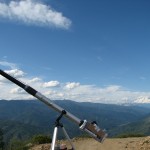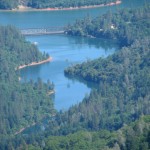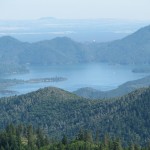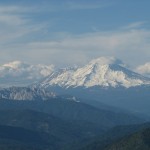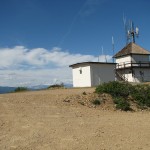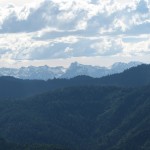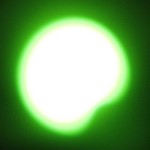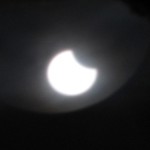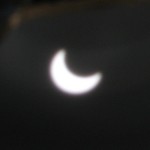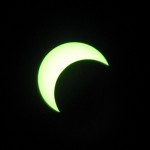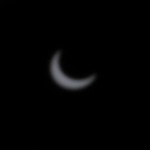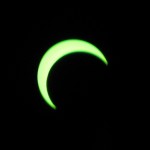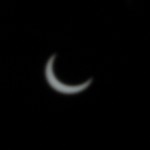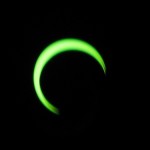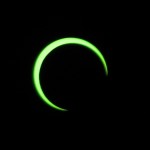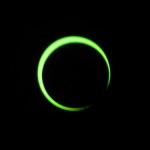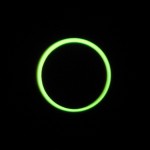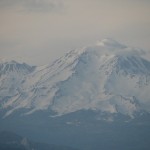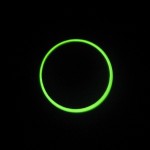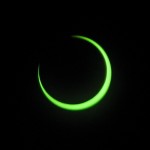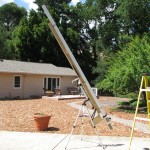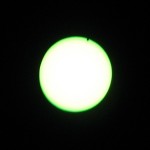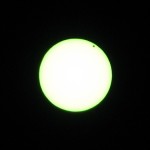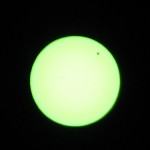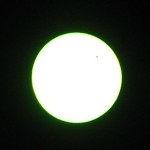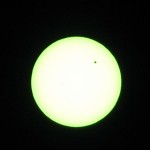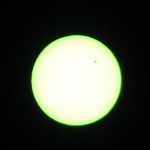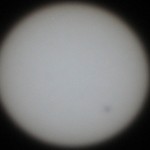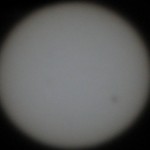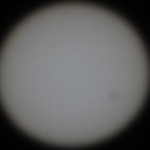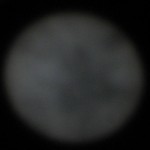For Feliks.
I’m diverting from the usual blog topics to chronicle some goings-on in our neighborhood. Sol, Venus, and Luna have been aligning for some remarkable views from Earth. First up is the May 20, 2012 Annular Eclipse. I chose as my vantage the top of Sugarloaf Mountain at the head of Doney Creek on Lake Shasta, California.
I grew-up summers on Doney Creek in the 60’s and early 70’s, and remember in those days the hillsides and mountains around the lake dominated by manzanita, the forests in the region having been largely destroyed by copper mining in the area around the turn of the 20th century; not so much the mining as the smelting. The dirt road to the lookout starts at Grandpa Fox’s old house on Doney Creek and climbs nearly 2,000 feet (600 m) to the top of Sugarloaf. I hadn’t made this trek in 40 years. The forest had grown up much more around the road than I remembered. At any rate I know I had never been up the mountain at this time of year, and it was really beautiful. A little late in the season for poppies, but the woolly bluecurls were blooming in abundance.
A half mile from the summit the road was closed. The Forest Service still had not opened the lookout for the fire season. Here was a little group of observers with “real” equipment (reflector telescopes and cameras with proper filters). But I was going all the way. So I slung my telescope, tripod, camp chair, and courier bag over my shoulders, donned my straw hat, and made for the lookout like some itinerant tinker.
The view from the top was well worth the climb: Mt. Shasta, Mt. Lassen, Lake Shasta, the Sacramento Valley, the Marysville Buttes, the Trinity Alps, and the Castle Crags. The party down the mountain had the better equipment, but I had the view…to myself.
My equipment was not that bad. Observing the sun with a pinhole telescope (camera obscura) is somehow sublime in a way I cannot describe, and I could not take a photograph that captures it either. None of the photos of the pinhole screen I attempted at maximum eclipse, the sublimest of moments, even turned out. I had the shutter speed set too fast. Held over the lens of my camera good old shade 14 welders glass produced much better photos.
Jim Welsh was in the party down the mountain from me with the real equipment. And while he didn’t get all the views I did, he put together this awesome (and I’m not using that overused word lightly) timelapse of the eclipse from Sugarloaf Mountain, California.
Well, here are the particulars of the event from my observation post, followed by photos. Notice the photos of the pinhole screen show the event vertically inverted (upside down). The focal length of my pinhole telescope was 63 inches (160 cm).
| Lat.: 40.9144° N | Annular Solar Eclipse, Magnitude: 0.967 | ||||||
| Long.: 122.4449° W | Duration of Annularity: 4m44.5s | ||||||
| Date/Time (UT) | Alt | Azi | Date/Time (PDT) | ||||
| Start partial eclipse: | 5/21/2012 12:10:58 AM | 034.6° | 267.5° | 5/20/2012 5:10:58 PM | |||
| Start annular eclipse: | 5/21/2012 1:25:45 AM | 020.6° | 279.4° | 5/20/2012 6:25:45 PM | |||
| Maximum eclipse : | 5/21/2012 1:28:08 AM | 020.1° | 279.8° | 5/20/2012 6:28:08 PM | |||
| End annular eclipse: | 5/21/2012 1:30:30 AM | 019.7° | 280.1° | 5/20/2012 6:30:30 PM | |||
| End partial eclipse: | 5/21/2012 2:36:03 AM | 007.8° | 290.1° | 5/20/2012 7:36:03 PM | |||
- My 63 inch pinhole telescope atop Sugarloaf Mountain
- Doney Creek, my childhood stomping grounds
- Lake Shasta, Sacramento Valley, with the Marysville Buttes in the distance
- Mt Lassen shortly after maximum annularity
- Mt Shasta and the Castle Crags before the eclipse
- Sugarloaf Lookout, not yet manned for the fire season. Mt Shasta in the background.
- The Trinity Alps off to the east, where the sun was going down
- Annular Eclipse just beginning
- The pinhole telescope screen showing the start of the eclipse
- Annular Eclipse, shade 14 welders glass
- Annular Eclipse pinhole telescope
- Last decent photo of pinhole telescope screen
- Very close to total annularity
- …almost there!
- Maximum eclipse annularity
- Mt Shasta during eclipse maximum
- A shade past perfect centering of the moon over the sun.
- …and the great event is past
The Transit of Venus on June 5, 2012 was much less dramatic, both in the event and the observational circumstances (my back yard in Danville). Even so I was much better equipped, with a 129 inch (328 cm) pinhole telescope. This one projected an image of the sun an inch and a half (3.8 cm) in diameter. You could just discern sunspots, which was my criteria for success. Even so, I still couldn’t adequately capture the images in photos. Shade 14 welders glass once again provided the best photos.
…and the much more interesting timelapse, courtesy of Jim Welsh.
- Transit 129 inch pinhole telescope
- The limb of Venus first crosses the solar perimeter
- Transit of Venus shade 14 welders glass, light cloud cover
- Transit of Venus with pinhole telescope
- Wispy clouds show up on the pinhole sreen

